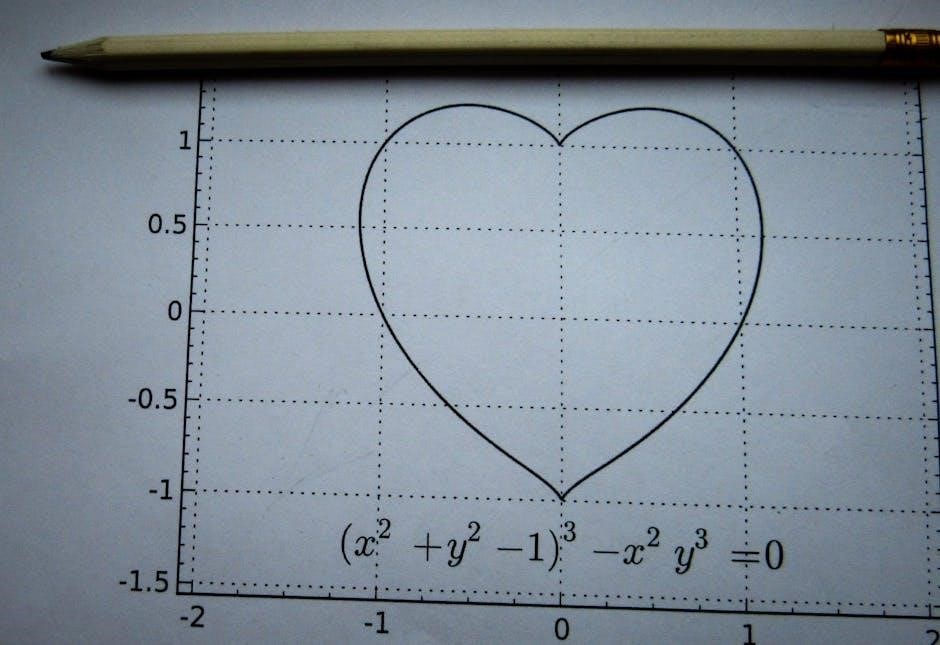Polar Coordinate Graph Paper: An Overview
Polar coordinate graph paper‚ distinguished by concentric circles and angular divisions‚ facilitates the plotting of points using polar coordinates (r‚ θ)․ These coordinates represent a point’s distance from the origin and its angle relative to the polar axis․
Definition of Polar Coordinate Graph Paper
Polar coordinate graph paper‚ also known as polar graph paper‚ is a specialized type of graph paper designed with concentric circles divided into equal angular segments․ These circles‚ centered at the pole (origin)‚ provide a visual framework for plotting points in a two-dimensional coordinate system using polar coordinates․ Unlike Cartesian coordinates (x‚ y)‚ which rely on horizontal and vertical distances‚ polar coordinates use a radial distance (r) from the pole and an angle (θ) measured counterclockwise from the polar axis (positive x-axis)․ Each point on the paper can be uniquely identified by its (r‚ θ) coordinates‚ making it a powerful tool for representing and analyzing data in various fields‚ including mathematics‚ engineering‚ and physics․ The concentric circles represent constant values of ‘r’‚ while the angular segments represent constant values of ‘θ’․
Purpose of Polar Coordinate Graph Paper
The primary purpose of polar coordinate graph paper is to provide a visual aid for plotting and analyzing data in the polar coordinate system․ This system is particularly useful for representing phenomena that exhibit radial symmetry or angular periodicity․ By using polar graph paper‚ one can easily plot points defined by their radial distance from the origin (r) and their angle relative to the polar axis (θ)․ This makes it ideal for graphing functions expressed in polar form‚ such as spirals‚ cardioids‚ and lemniscates․ Furthermore‚ the paper facilitates the comparison of graphs with minor differences‚ aiding in identifying patterns and trends․ Engineers and mathematicians frequently employ it for plotting data related to circular or rotational systems‚ signal processing‚ and complex analysis․ In essence‚ polar coordinate graph paper simplifies the visualization and interpretation of data in contexts where radial or angular relationships are paramount․

Key Features and Uses
Polar graph paper is characterized by concentric circles representing radial distance and angular segments denoting angles․ This structure simplifies plotting and analyzing data in polar coordinate systems․
Concentric Circles and Angular Segments
Polar graph paper features a distinctive design comprised of concentric circles emanating from a central point‚ the pole‚ with equally spaced angular segments radiating outwards․ Each circle represents a specific radial distance (r) from the pole‚ while the angular segments denote angles (θ) measured counterclockwise from the polar axis․
The concentric circles provide a visual guide for plotting the radial component of a polar coordinate‚ allowing users to easily identify points at varying distances from the origin․ The angular segments‚ typically marked in degrees or radians‚ facilitate precise measurement and plotting of angles․
The intersection of a circle and an angular segment defines a unique point on the graph‚ enabling the accurate representation of polar coordinates․ This structure is fundamental to the paper’s utility in mathematical and scientific applications‚ offering a clear and intuitive framework for visualizing polar functions and data․
Plotting Points in Polar Coordinates (r‚ θ)
Plotting points on polar graph paper involves interpreting the (r‚ θ) coordinates․ The ‘r’ value indicates the distance from the pole‚ corresponding to a specific concentric circle․ The ‘θ’ value‚ measured in degrees or radians‚ determines the angle from the polar axis‚ aligning with a particular angular segment․
To plot a point (r‚ θ)‚ locate the circle representing the ‘r’ value and the angular segment corresponding to the ‘θ’ value․ The intersection of these two elements marks the location of the point․ For instance‚ (5‚ 45°) would be found on the circle representing a radius of 5‚ along the 45-degree line․
Understanding this process allows for the visualization of mathematical functions and data in a circular coordinate system․ Polar graph paper simplifies the process of representing complex numbers and equations‚ which are often more easily expressed in polar form than in Cartesian coordinates․
Applications in Mathematics and Engineering
Polar coordinate graph paper finds extensive applications in mathematics and engineering․ In mathematics‚ it is instrumental in visualizing complex numbers‚ graphing polar equations like cardioids and lemniscates‚ and exploring concepts in calculus involving polar coordinates․ Its circular grid facilitates understanding functions with radial symmetry․
Engineering disciplines such as electrical engineering‚ mechanical engineering‚ and aerospace engineering utilize polar graphs for various purposes․ Electrical engineers use it to represent impedance and admittance in AC circuits using Smith charts‚ which are based on polar coordinates․ Mechanical engineers employ it to analyze rotating systems‚ such as engines and turbines‚ where angular measurements are crucial․
Aerospace engineers use polar plots to represent antenna radiation patterns and to analyze the performance of aircraft in flight․ The ability to represent data in a circular format makes polar graph paper a valuable tool for analyzing and designing systems with rotational or radial characteristics․

Printable Polar Graph Paper Templates
Numerous printable polar graph paper templates are readily available‚ offering convenient solutions for mathematical and engineering tasks․ These templates often come in PDF format for easy access and printing․
Availability of Free PDF Templates
Numerous websites offer free polar graph paper templates in PDF format‚ catering to diverse needs in mathematics‚ engineering‚ and design․ These readily accessible resources eliminate the need for manual creation‚ saving time and effort․ Users can download and print these templates as needed‚ making them ideal for educational settings‚ professional projects‚ and personal use․

The available options often include various grid densities‚ angular divisions (e․g․‚ 10‚ 15‚ or 30 degrees)‚ and labeling schemes (degrees or radians)․ Some websites also provide customizable templates‚ allowing users to adjust parameters like line weight and circle spacing to suit their specific requirements․
These free PDF templates are invaluable tools for anyone working with polar coordinates‚ offering a convenient and cost-effective way to create accurate and visually appealing graphs․
Variations: Degree and Radian Labels
Polar graph paper comes in variations distinguished by their angular labels: degrees or radians․ Degree-labeled paper divides the circle into 360 degrees‚ a familiar unit for many․ Each spoke represents a specific degree measure from 0 to 360․
Radian-labeled paper‚ on the other hand‚ uses radians‚ a unit based on the radius of the circle․ A full circle is 2π radians․ Radians are commonly used in advanced mathematics and physics‚ especially when dealing with trigonometric functions and calculus․
The choice between degree and radian labels depends on the application․ For introductory geometry or basic plotting‚ degree labels might be more intuitive․ However‚ for higher-level math or scientific work‚ radian labels are often preferred․ Both types are readily available as printable PDF templates․
Grid Spacing Options (10‚ 15‚ 30 Degrees)
Polar graph paper offers varied grid spacing‚ typically 10‚ 15‚ or 30 degrees between spokes․ This spacing influences plotting precision․ Ten-degree spacing provides the finest resolution‚ enabling precise point placement․ Fifteen-degree spacing balances detail and clarity‚ suiting general use․ Thirty-degree spacing simplifies plotting‚ ideal for visualizing broad trends or introductory exercises․
The choice hinges on application needs․ Detailed plotting benefits from 10-degree spacing‚ while general sketches suffice with 30-degree spacing․ Consider the complexity of the function or data when selecting․ Many free PDF templates offer these spacing options‚ allowing users to choose according to their project’s demands․ Remember that denser grids can sometimes appear cluttered․ Experiment to find the best balance for your work․

Customization and Creation
Online polar graph paper generators empower users to create tailored templates․ These tools offer customization of line weight‚ circle spacing‚ and angular divisions‚ enabling precise adaptation to specific project needs;
Online Polar Graph Paper Generators
Numerous online graph makers provide the functionality to create custom circular or polar graph paper‚ streamlining the generation of printable templates․ These tools often allow users to define parameters such as paper format (A3‚ A4‚ Letter)‚ customize grid spacing‚ and adjust line weights to meet specific requirements․ Polar graph paper‚ also known as polar coordinate paper‚ features concentric circles divided into equal angular segments‚ facilitating the plotting of points in polar coordinates․
The ability to tailor these templates makes them invaluable for mathematical‚ scientific‚ and engineering applications․ Some generators even offer options for radian or degree labels‚ further enhancing their versatility․ Users can preview changes in real-time and regenerate the graph as needed before downloading in PDF or PNG format․ The availability of these online generators significantly simplifies the process of obtaining customized polar graph paper for diverse plotting needs․ These generators offer a convenient and efficient way to create the exact graph paper needed for any project․
Customization Options (Line Weight‚ Circle Spacing)
When utilizing online polar graph paper generators‚ users encounter a wide array of customization options that extend beyond basic grid creation․ Adjusting line weight allows for emphasis on particular grid lines‚ enhancing readability and clarity․ Furthermore‚ circle spacing becomes adaptable‚ enabling the user to define the intervals between concentric circles based on the desired scale․
These customization features provide flexibility‚ catering to specific needs across diverse applications․ Whether working with intricate mathematical functions or engineering diagrams‚ the ability to control line weight and circle spacing enables a more precise and tailored representation․ Some generators also offer options for customizing the appearance of primary and secondary spokes‚ allowing for further refinement of the graph’s visual presentation․ By modifying line weight and circle spacing‚ users ensure their polar graph paper perfectly aligns with the demands of their project‚ leading to improved accuracy and clarity in data visualization․ The control over these elements ultimately facilitates more effective analysis and interpretation․
